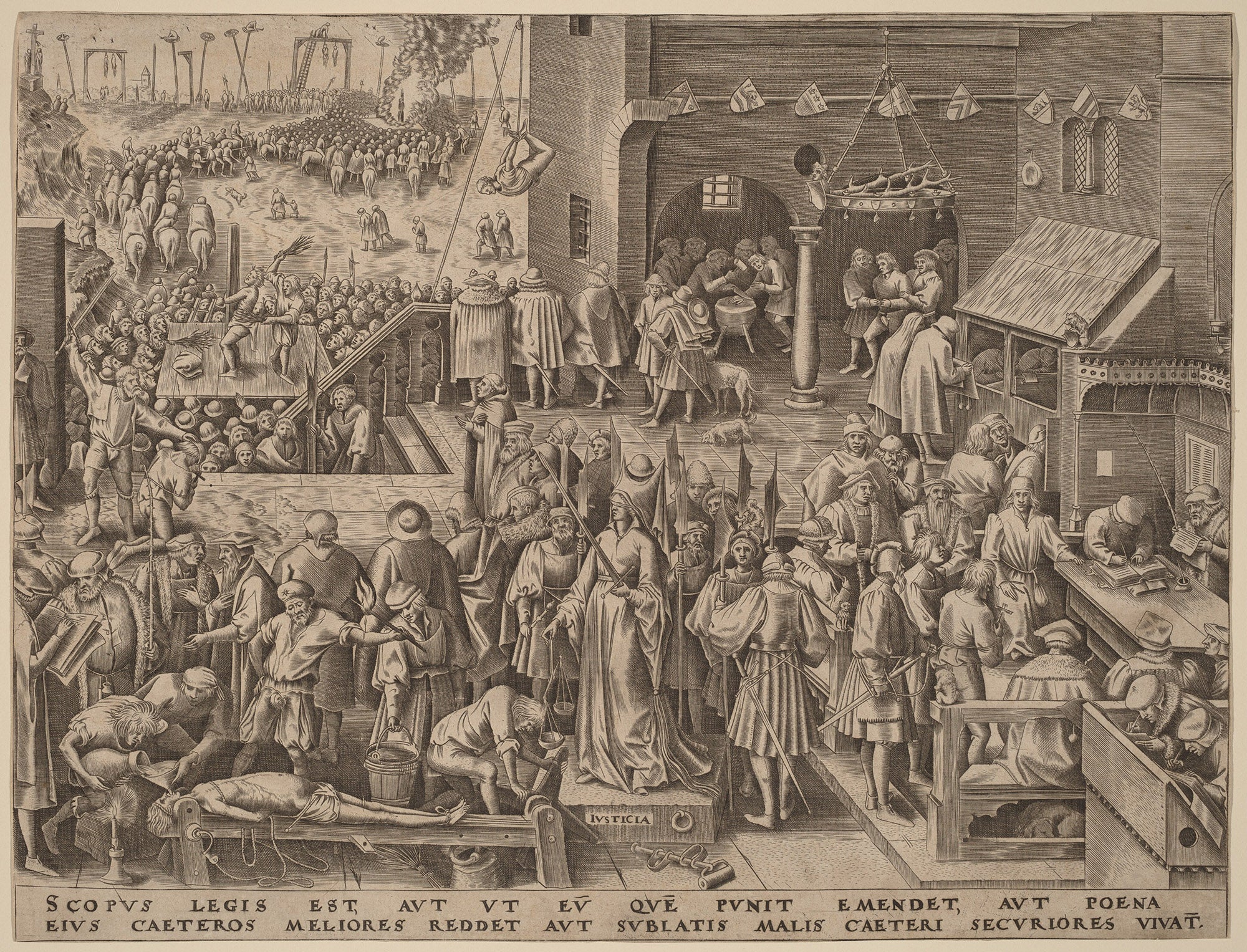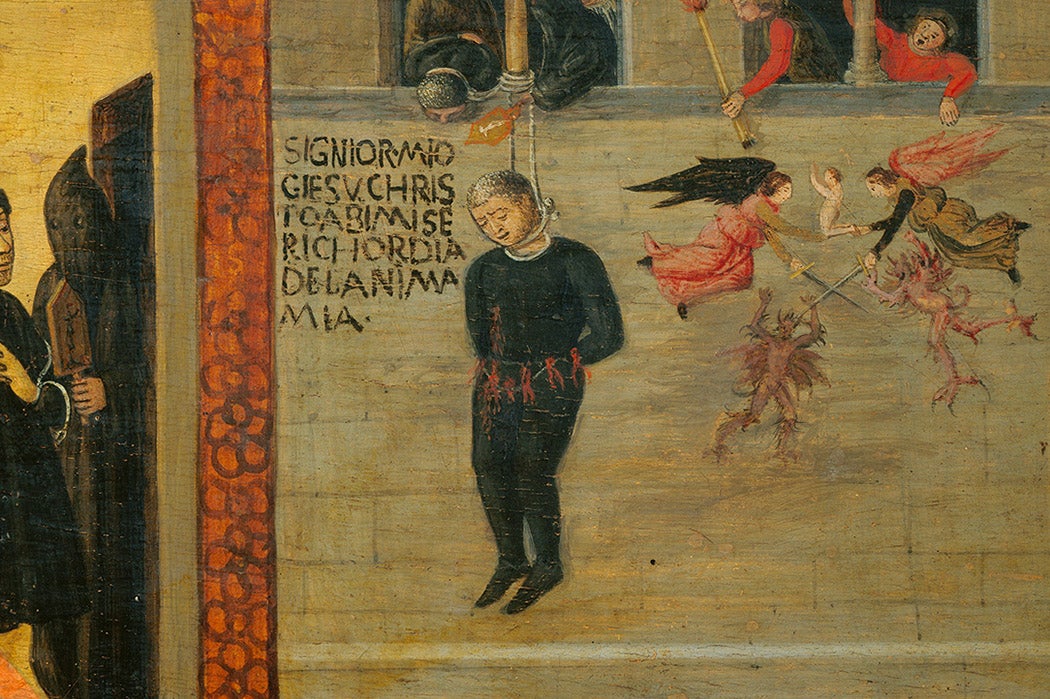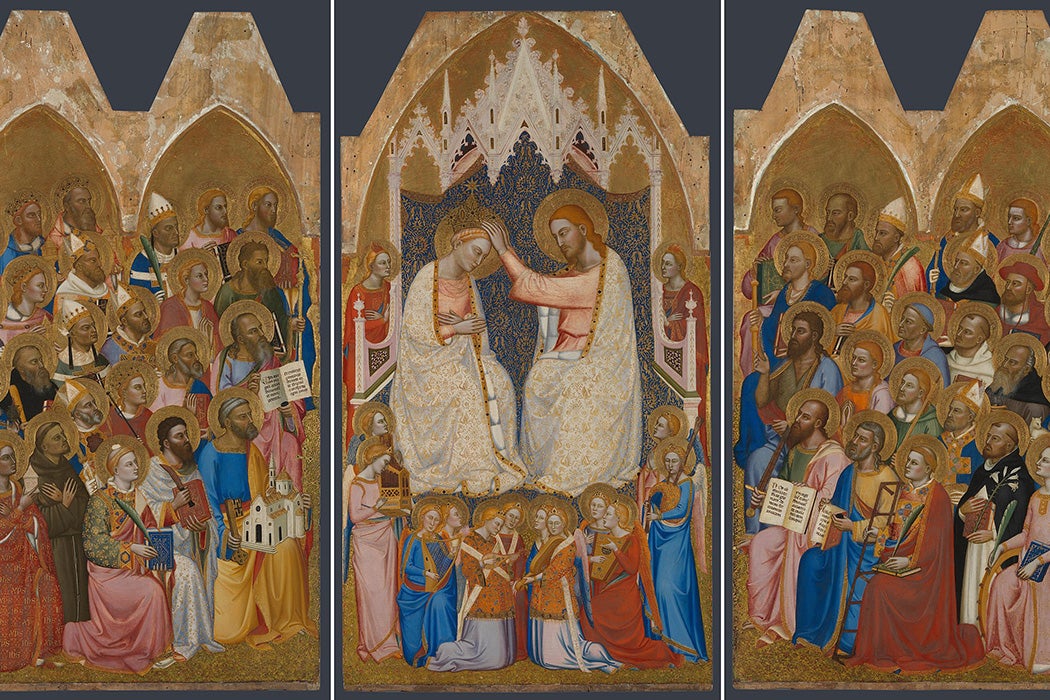In 1501, Antonio Rinaldeschi, Florentine and gambler, made a series of bad bets. Furious, and probably drunk, he scooped up a pile of horse dung from the street and flung it at a fresco of the Virgin Mary. He was even unluckier than he thought: the dung stuck. Within a few days, he was arrested and sentenced to death for blasphemy.
There’s a painting in Florence’s Museo Stibbert that depicts his execution. Rinaldeschi hangs from a window, his brow twisted in a final expression of anguish. Above him, a hooded figure dressed in black looks on. You might assume that’s the executioner, but the truth is almost the opposite: this was Rinaldeschi’s comforter, responsible not for his death but for his eternal salvation.
In his hand, the comforter carries a tiny painting of the Crucifixion, mounted on a stick. This image, called a tavoletta, would have been the last thing Rinaldeschi saw; the comforter’s job was to hold it up before his eyes as he took his final breath. The idea was that, if the condemned man’s last thoughts were of Christ, he’d be more likely to go to heaven. The artist, at least, was optimistic—in the corner, he’s painted Rinaldeschi’s soul ascending between a pair of angels, points out Samuel Y. Edgerton, Jr.
The comforters were members of a lay religious order devoted to instructing the “afflicted”—their euphemistic term for people sentenced to death. These orders were scattered through Italy, particularly in the north. (Michelangelo was a member of the Roman brotherhood.)
They arrived on the eve of the execution and tried to convince the condemned prisoner to, well, see the positive side of their impending end. A fifteenth-century guide, the wonderfully titled Comforters’ Manual of Bologna’s Company of Death, advises comforters to arrive with a smile on their faces, take the prisoner by the hand, and assure them that being executed was one of the best things that could happen to them. After all, most people have no idea when they’ll die, and life is full of devilish snares. Being executed gives you the chance to prepare yourself to die in grace. Even if the person insists they are innocent, the manual states that you should try and convince them that their death is for the best, reports Samuel Y. Edgerton.
More to Explore
When the Bishop Married the Abbess
This was the pitch, at least, though it couldn’t have been an easy sell. The manual admits that it’s often difficult to connect with the condemned person; usually they’d be talking in a crowded cell, with lots of other prisoners standing around gawking. But the most difficult part was the moments before execution, when the person was exposed to the jeers of the crowd, the sight of loved ones, and the sound of their sentence being read out. For this, comforters employed the tavoletta—the painting on a stick. They would hold it right up in front of the condemned prisoner’s face to keep them from being distracted by the crowd. Some tavolette even had blinders on each side, writes art historian Achim Timmermann.
As historian Nicholas Terpstra explains, “[t]he comforter did not represent the prisoner; questions of guilt and innocence were subordinated to the greater concern that a soul go to heaven and order be maintained on earth.” Ideally, the prisoner focused only on the afterlife, Terpestra writes, as
[p]risoners screaming their innocence or protesting their sentences from the Podesta’s Palace could stir private doubts in the crowded piazza and lead to riots in the street. Public disorder would discredit the local rulers in the eyes of their Papal overlords and possibly lead to dismissal from power.
On the other hand, in medieval Spain and France, writes Meryl Balley, prisoners were often denied the sacrament; going to Hell was considered part of the punishment. In Germanic lands, rather than carrying tavolette, they erected monumental “poor sinner’s crosses” to stand in the execution fields or along the path to reach them. The condemned person would kneel and gaze up at the carvings on the cross before their head was struck off. Chillingly, they were sometimes made double-sided, for greater efficiency—the better to behead two people at a time. Timmermann vividly describes the scene of executions, noting that site held
a number of upright wheels, from which human cadavers dangled in various states of decomposition. Adding to the stench was an apparently plentiful amount of manure, which was regularly left there by pigs digging through the soil of the execution site in search of edible scraps.

There’s a strange doubling between the figure of Christ and the condemned person. The doomed prisoner going to the block was urged to see themselves in Christ; the walk to the execution grounds mirrored the procession to Golgotha. You can see this doubling, Timmermann points out, in Pieter Bruegel the Elder’s engraving Justice, which shows a very bloody version of it. It’s a catalogue, more or less, of every horrible way for a person to be put to death: being stretched on racks, beaten, burned, or broken on wheels as blank-faced crowds gawk and the Lady Justice stands blindfolded on her plinth.
Weekly Newsletter
In the very far corner of the print, on a hill, we see the tiny figure of Christ on the cross. For all the crowds of people in the artwork, only two have made the trek up to the mount with the cross. Their backs are turned to us. Is it possible to read a subtle social critique into the image? After all, there’s something curious about a system that insists anyone can be redeemed in the next world but demands their blood in this one.
As for the unlucky Rinaldeschi, his story has a curious coda. The dung that stuck to the fresco happened to form the shape of a rosette—a marvel in the eyes of the Florentines. People laid out candles and votive objects before it; even the archbishop came to witness it. So Rinaldeschi’s blasphemy, though leading to his execution, also proved to be something of a miracle.








